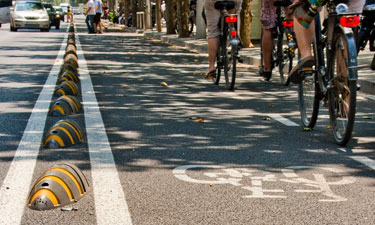 Houston, Texas, is one of the hottest markets in the country right now, both for businesses looking to expand or relocate headquarters and the employees who make up their expansive labor pools. Near boundless opportunity when it comes to development also makes planning in Houston a bit of a challenge, as thousands of new residents flock to the city with high expectations of ways to live, work and play. Groups like BikeHouston have been working hard to lobby area politicians and residents for infrastructure improvements that would not only benefit cyclists, but reduce air pollution and road congestion, helping the city to live up to high expectations of the future. The soon-to-be-completed protected bike lane on Lamar Street in downtown is one such project — the first of its kind in Houston — and hopes are it won’t be the last.
Houston, Texas, is one of the hottest markets in the country right now, both for businesses looking to expand or relocate headquarters and the employees who make up their expansive labor pools. Near boundless opportunity when it comes to development also makes planning in Houston a bit of a challenge, as thousands of new residents flock to the city with high expectations of ways to live, work and play. Groups like BikeHouston have been working hard to lobby area politicians and residents for infrastructure improvements that would not only benefit cyclists, but reduce air pollution and road congestion, helping the city to live up to high expectations of the future. The soon-to-be-completed protected bike lane on Lamar Street in downtown is one such project — the first of its kind in Houston — and hopes are it won’t be the last.
Smart Infrastructure
Downtown Houston is already pretty smart, planning-wise — it’s comprised of a neat grid of streets and complemented by light rail that runs the length of the city. The Gulf and Eastex Freeways hug the borders of the city’s core, and despite a large number of drivers commuting in and out each day, “we find the traffic volumes in downtown are pretty stable,” says Jeffrey Weatherford, deputy director of traffic operations for the Houston Department of Public Works. This was a fortunate observation, as Weatherford’s agency is managing the construction of the new protected bike lane, which will run about three-quarters of a mile down Lamar Street, connecting Discovery Green and Sam Houston Park. It will occupy a “mobility/parking lane,” that in the past has accommodated rush-hour traffic from 7-9 a.m. and 4-6 p.m. and served as on-street parking during all other hours. Weatherford says his office did a fair amount of outreach to those folks concerned about increased delays as a result of losing that lane — “If you close a lane on one street, traffic temporarily diverts… Overall traffic volumes are not projected to grow all that much [after the bike lane is completed] — we have the spare capacity on the roadway.”
Once finished, the protected bikeway “will be a two-way cycle track running along the southernmost parking/mobility lane,” Weatherford says. “It will have one 4.5-foot bike lane in each direction and a 2- to 3-foot wide painted median separating the bikes from motor vehicle traffic. We will be installing armadillo delineators in this median area and the bike lanes will be painted green with bicycle symbols.” The “armadillos” to which Weatherford refers are what sets this protected area apart from other bike lanes that are simply painted on a roadway. “It’s a hump of molded plastic about 8 inches off the ground, 8-10 inches wide and 18 inches long — if you hit them with your car it wouldn’t be good,” says Michael Payne, executive director of BikeHouston. Not that Payne and his supporters have it in for motorists; rather, they’re looking to afford adequate protection to cyclists. “This kind of protected bikeway is a physical barrier that makes it safer for cyclists to bike,” he says. “It’s a significant milestone for Houston — its first on-street protected bikeway. It’s an indication we’re evolving and we’re implementing improvements to encourage more people to cycle.”
Ongoing Journey
With this latest project, Houston is well on its way to becoming a truly bike-friendly city. “The City of Houston has invested a substantial amount of funding into a bike/pedestrian trail system along our bayous and abandoned rail corridors over the years,” Weatherford says. “What you are seeing in this particular project is one effort to connect/fill a gap in the trail system, specifically between the Buffalo Bayou Trail and the Columbia Tap Hike and Bike Trail.” Studies commissioned by the city showed a significant resident interest to have some type of bicycle connection across the downtown area — the protected lane accomplishes that goal, plus Weatherford’s stated objectives of further connecting the trail system and aforementioned parks.
Payne is hopeful that this is merely the start of a robust and ongoing campaign to put Houston on the map as one of the country’s best cities for cyclists. “Mayor [Annise Parker] really embraced this plan,” he says. “She agreed to a [Bicycle] Master Plan, put more undercover police on bikes out on the streets to create a safer environment… She has shown a real willingness to address these issues.”
That willingness, on the part of elected officials and the voters who put them in office, is what Payne and his colleagues are banking on as they advocate for more protected bike lanes and similar projects for the future. “I’m optimistic,” Payne says. “I think there’s a lot of opportunity for improving conditions for cyclists in Houston — improvements that will benefit broader society by getting cyclists off high-volume, high-speed roads, improving people’s health and encouraging people to get out and move around… If you communicate the benefits, people get it.”
Samantha Bartram is the Associate Editor of Parks & Recreation Magazine.

